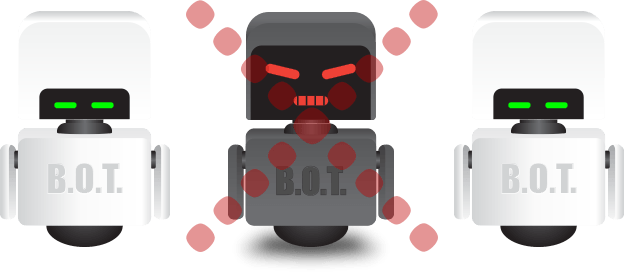Try CDNetworks
For Free
Most of our products have a 14 day free trial. No credit card needed.

A bot is a program that performs certain actions without needing further human intervention. Bots are designed to automate routine and repetitive tasks that would otherwise take humans much longer to complete and do so without errors.
Bots can be programmed to do tasks such as filling out and submitting forms, crawling web pages, or downloading content. They can also interact with users on social media platforms by liking, following, or other interactions. Examples include Google crawlers and chatbots that automate responses to FAQs on websites.
Not all bots are created equal or with the same intentions. Some are designed for legitimate purposes, while others are created to cause harm.
Good bots assist humans with services such as search engine crawlers, customer support chatbots that handle FAQs, and bots that monitor website performance for anomalies. Any website incorporating a bot should adhere to the rules in the robots.txt file outlined by Google.
Bad bots misuse products, harm websites, or disrupt services. Specific examples include email harvesting bots that spam users to collect email addresses, bots attempting to hack user accounts, and others that consume website resources.
Sometimes bots can be remotely controlled in a network called a botnet, used to launch cyberattacks like DDoS attacks.
Bot management involves real-time protection and the blocking or filtering of malicious internet bot traffic while allowing good bots to pass through. Good bots, such as Google crawlers, should be permitted. Bot management’s primary purpose is to detect suspicious bot activity, identify undesirable behaviors, and locate the bot’s source.
Bot managers work by blocking malicious bots from hijacking assets, thereby strengthening website security and reliability. They eliminate bad bots and guide good bots correctly to improve the user experience and protect the business from losses and reputational damage.
A bot manager is a software product that helps distinguish bots from human visitors, analyzes bot behavior, reputation, IP addresses, and enables the allowlist of “good” bots.
For instance, Google uses bots to index web pages to rank them in search results. If these good bots are not allowed, it could affect a website’s ranking and organic traffic.
Bot managers may use security solutions like machine learning algorithms and threat intelligence to assess bots, detect and block suspicious activity, while allowing legitimate bots to operate without interruption.

There are three main approaches to bot detection:
Bot mitigation services can automate these approaches, monitor traffic, and implement rate-limiting to restrict bots instead of focusing on a single IP address.
Bot management functionality can vary slightly between providers. Common bot attacks that managers address include:
Without sound bot management solutions, your business is vulnerable to various bot attacks that range from intellectual property theft, phishing attacks, and spam to other dangerous cyber-attacks. Proper bot management is essential to prevent significant business damage.
On December 3, 2025 (EST), a critical security vulnerability was discovered in React Server Components, rated with a CVSS score of 10.0.
We continuously innovate to meet the evolving challenges of WAAP in today’s digital ecosystem. In this post, we’ll explore the key capabilities of the CDNetworks WAAP solution.